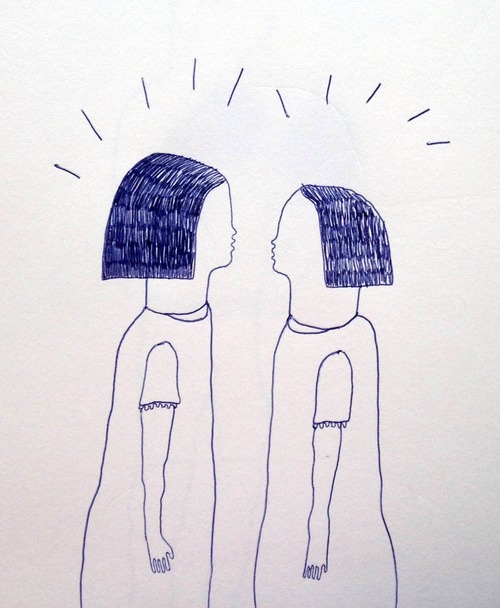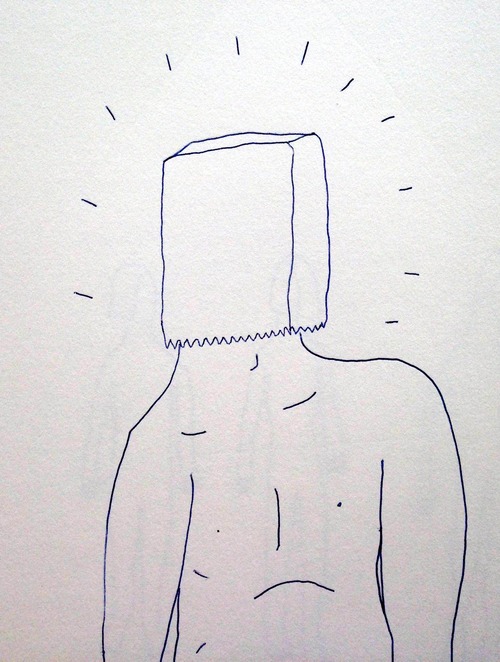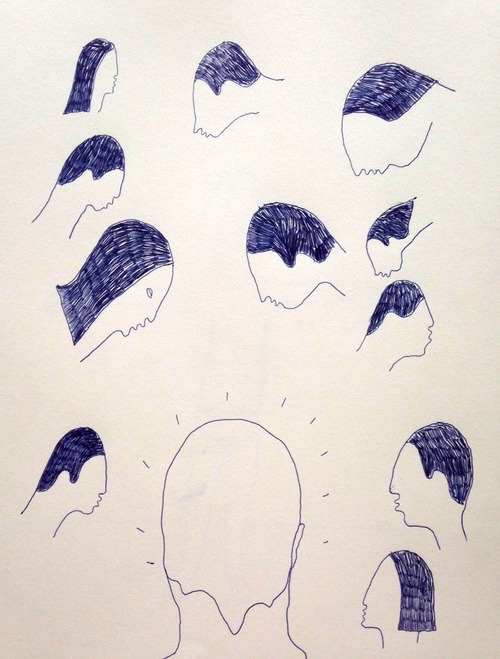
In this series five different writers talk to one writer about five (or more) of his different books. In this fourth interview, Amina Cain talks to Brian Evenson about Fugue State. Read the first interview with Colin Winnette, the second with Matt Bell, the third with Brian Conn.
Amina Cain in Conversation with Brian Evenson
Before sitting down with Fugue State for the first time, I got to hear Brian Evenson read the opening story of the book—“Younger”—at the Summer Writing Program at Naropa in 2005. I couldn’t get the story out of my head, or the way it began, already in conversation with something: “Years later, she was still calling her sister, trying to understand exactly what had happened.”
I was affected by how direct the language was—and how soothing—to tell this kind of story: a confusion of memory and perception between two sisters and a vivid, filmic scene from their childhood. But whatever I first felt the language (and narrative) was doing, it seemed to multiply until I was adrift in it too, this shared yet helplessly separate landscape of the sisters. All of the pieces that make up Fugue State are places as much as they are stories, like “In The Greenhouse” (here, place is a book or a character’s mind as much as it is a house surrounded by pines), and the reader enters them, though not to find any kind of resolution or protection.
The book brings us into contact with thinking itself, with a sense of terror that seems to multiply plainly, and with the most difficult kinds of truth.
—Amina Cain
I. DISORIENTATION
AMINA CAIN: One of the things I was left with after reading Fugue State was a profound sense of disorientation, of being lost. Many of the characters in the stories don’t understand what is happening to them or what is actually real. As a reader, and as a person, I often enjoy disorientation. What is your relationship to it? Is there something in it you find, not useful, but interesting or necessary as a place from which to write?
BRIAN EVENSON: I enjoy disorientation a lot too, though more as a reader than as a person, unless it’s recreational disorientation (I’m not that keen about getting lost in buildings, for instance, unless they’re very particular kinds of buildings). I think a good many writers see writing as something that helps them sort out and pin down the world, that allows them to organize it. I want my writing to do the opposite: to destabilize systems and orders and make everything seem a little less certain. There are various ethical and political reasons for wanting to do that, but I think the main reason is a philosophical one: first, I’m genuinely convinced that the world really is a great deal less stable than we choose normally to experience it, and second, I feel that writing should allow us to perceive that.
AC: “Younger” is one of my favorite stories of all time, and whenever I read it I’m struck by how well it conjures a subtle sense of terror without “doing anything” with that terror, i.e. nothing horrible happens in the events of the story itself, and yet we know what comes later for the girls’ parents. For me, some of this terror arises out of the images of the story—how the sisters outfit themselves with rubber bands and plastic bread bags—and their vulnerability. I wonder if you could talk a bit about this story—in any way you’d like—and/or speak to the sense of terror within it.
BE: “Younger” is one of the three stories I’ve written that I’m happiest with, and I’ve stayed happy with it for a long time. I’ve found that the stories I’ve written that I continue to like are stories that I don’t fully understand how they do what they do—that there’s a great deal being done subtly and by inference, and I can’t locate the place in the story where a particular effect is being achieved: it’s just suddenly there. I remember when I was an undergrad how excited I was the first time I read Raymond Carver’s stories, and then how disappointed I was the second time I read them: the mechanics of the story became too obvious after that first read, with the exception of a very few stories. “Tell the Women We’re Going” for instance: that truncated ending shouldn’t work, but it does, and in a way that still retains just a little bit of its stylistic mystery. So I can probably only talk about part of what makes “Younger” work, and may not get very far in terms of understanding certain aspects of it. Part of what makes “Younger” work, I think, is the looming threat of what will happen to the parents. But then there’s also the ritual nature of the children’s playing. But, I think, more important than that is the way that the game is played and then replayed in a way that erases or destroys it. There’s something about that gesture, of building up a world in a way that’s almost ecstatic, the exhilaration of that, and then going back and destroying everything, rubbing everything out, that’s extremely frightening to me. I didn’t know that they were going to do that until they were in fact doing it, until I was in fact writing it. But as soon as I started writing that, I could see how I’d unconsciously prepared for it. I think the other thing is that I worked on that story while I was living alone, away from my family, just seeing them every three or four weeks, in family housing at Syracuse University. There was something about that isolation that allowed me to project very strongly into that childhood space and populate it with a mix of moments of remembered embodied play from my own childhood and observed and remembered play from my children’s childhood—the stove was the stove in my ex-wife’s house, but the game with the rubber band is something my sister and I used to play. I don’t know why I think that that projection increases the unsettling quality of it, but I do.

II. COSTUMES OF EXHILARATION
AC: What you say here makes me think too of “Windeye,” from another book of course, but another favorite story of mine, and similarly subtle and mysterious and beautifully clear in its language to “Younger.”
I know what you mean about not understanding completely how a story does what it does. Lately I’ve been wondering what certain images or lines are doing in my own stories, and I am okay with not knowing, and feel regardless that they very much belong, that they help create the world they’re a part of. I think the uncertainty you talk about in “Younger” is something the reader can get close to; I mean, there is an embodied experience for the reader as well. The reader is not outside that uncertainty; the reader has walked inside, is there in that house and in the beginnings of that terror, while also relating at times to the older sister and the crazy feelings that produces. I also relate to what you say about the ritual nature of the children’s playing, how heightened it is, and then the destruction of it while still, in a sense, wearing the costumes of exhilaration. I can’t quite describe the feeling I got in my own life when I realized pleasure and pain were two sides of the same coin. And I’m very interested in that idea of projection into a story from one’s own experiences, so that it’s not about writing one’s life or parts of it into a story, but that they are beamed in, are in relationship in some way to what is happening in the story itself.
I didn’t mean to say so much, but your answer made me think of many things. I guess if there’s a question here, it would be something about how different aspects of a story interact. Because we’re taught at an early age to talk about fiction through the elements of character, dialogue, setting, plot, etc. we sometimes lose the ability to talk about a work of fiction on its own terms, through the things that are deeply present and important to it.
BE: Yes, that strikes me as being it exactly. I think certain sorts of stories bring you into their experience, make you feel like you’ve fallen into their world and sometimes there’s an almost palpable sensation when you finish those sorts of stories, like you’re coming up for air. And I do think there’s something about fiction that’s about intensity and shared experience, and that’s tied, finally, to a willingness on the part of the reader to be generous, to share in the risk, if that makes any sense. I am asking readers to go through intensive experiences in my fiction, and I can’t ask, in good conscience, for them to do that unless they feel that I’ve got something at stake as well, something real. A great many of the stories that fail for me don’t fail because of technical imperfections but because there’s something numinous that just isn’t quite there, some sense that not enough is at stake. If I’m to expect my readers to share the lives of these two girls in “Younger,” I really need to have had the same sort of intensive, genuine experience with them.
I almost never talk about fiction this way because I think it’s too often misunderstood. It’s not so much that I’m saying “I think of my characters as real” as I’m saying, “We construct our characters from words and make them real, and by doing so realize that we too are constructed of words.” But that doesn’t make the communion that we can feel in relation to them and their joys and confusions and sufferings any less real. It makes me happy that people can have an intensive experience with a story like “Younger,” since my own experience writing it was so intensive and I relive aspects of that any time I read the story aloud.
A lot of the way I think about that aspect of fiction comes from Alphonso Lingis and his philosophy, which strikes me as a philosophy that’s simultaneously of generosity, vulnerability and excess. That combination is a remarkable one, and encourages you to be open to a wide range of experience and also open yourself up to others. And it makes me less interested in judging people than in trying to understand them. His book The Community of Those Who Have Nothing in Common was an incredibly important book for me, along with a number of others.
III. HEADS IN THE EMPTINESS
AC: As readers, as people, what can we learn from violence?
BE: I think there are limits to what we can learn from violence, but I guess that’s true about almost anything. My earlier work was very interested in presenting violence very flatly, in a kind of moral void. I felt that if the reader was giving it without being told what to think it would generate an ethical response on their part, even if that response was one of revulsion. I think my more recent work, particularly my novels, thinks about violence very differently. In both Last Days and Immobility we are exposed to the character’s thinking and wondering about what they’re doing and what it means for them. In Last Days in particular the question of to what degree you become the things you do haunts the main character without him ever being quite able to resolve it. In the recent stories, I think violence ends up being used along a sort of continuum, with the reader allowed different degrees of distance for different stories, and sometimes different degrees of distance within the same story. So many of my characters struggle between repressing what they’ve done or seen and acknowledging it.
I think we learn less from violence itself and more from watching how people react to it, either as participants or as witnesses. And, of course, fiction allows us a certain degree of protection and objectivity that violence in the world does not.
AC: Even in Fugue State, the idea of a continuum makes sense to me when thinking about violence. In “Traub in the City,” for example, if there’s a violence it’s in the nature of death itself, not in one thing done to another or oneself. Though I wonder, is it a sort of violence to see another die? Traub sees this so intimately, through drawing a dying man’s profile, but because of the rapidity of death he can’t hold onto any of it and then he is haunted: “He began to see heads in the emptiness, in all the space that surrounded them, isolated and remote.” This story is so interesting to me, and there is an awful realization in it, one I have never had myself in quite that way, but that when I read felt immediately true. How separate we are. How our relationships to other things will leave us. How did you come to write this story? How did it unfold for you in the writing of it?
BE: Yes, I do think it’s a sort of violence to see another die. It’s a terrible thing. But at the same time one of the kindest acts we can do is sit beside someone as they die, that act of just being present. Traub’s in a strange position in that he can’t quite bring himself to have an unmediated experience with another human, one that breaks through the separateness, and that’s at least partly due to his art, his commitment to it. But at the same time, something does happen to him in the story. He’s shaken, if nothing else, and nearly catches sight of himself.
I’m not quite sure where it came from. I know I wrote that and the story “Bauer in the Tyrol,” which shares some connections and even some specific language with it, just after translating two essays by Jacques Dupin on Giacometti for the book Giacometti: Three Essays. Those essays haunted me, and I was haunted too by Giacometti’s drawings, and I think I have one or two near quotes from the translation in both stories. I’ve always liked his sculpture, which is what he’s known for, but I think his drawings and paintings are just exceptional and devastating. His linework in his drawings are also extremely recursive, as if he’s trying both to create an image and destroy it at the same time. That’s probably at the heart of both stories. I wrote “Bauer” first, felt that it did something I was satisfied with. “Traub” distilled something else and did it much more simply and more deftly. I couldn’t have written it, though, without having written “Bauer” first.

Week 1: Colin Winnette on Baby Leg and Dark Property.
Week 2: Matt Bell on The Open Curtain.
Week 3: Brian Conn on Immobility.




